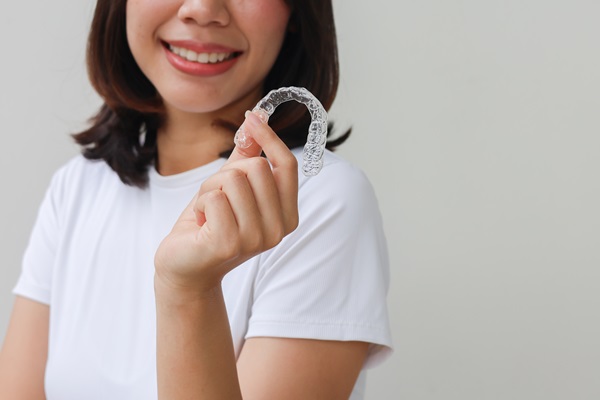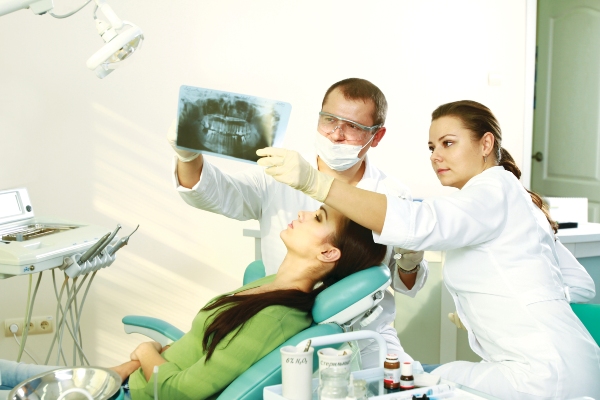Invisalign and Your Gums as Your Teeth Gradually Shift

If you have opted for Invisalign®, you have taken the first step toward achieving a straighter, healthy smile. With the focus on getting straighter teeth, many people ignore the benefits of the treatment on the gums. Continue reading to learn more about how Invisalign affects the gums.
An overview of Invisalign
Invisalign is a pair of transparent aligners for patients who need to realign their teeth. Invisalign patients do not have to deal with metal braces; instead, they wear a set of custom-made, removable aligners. These aligners are almost undetectable and quite comfy. They are also hard to spot on the teeth.
Patients must wear these aligners for a certain number of hours each day. Every one to two weeks, or as instructed by the dentist, patients will get a new set of personalized aligners. The teeth will progressively move over time to the desired position.
Invisalign braces are completely safe to wear. The material carries minimal to no risk at all. The dentist will evaluate the patient to know if Invisalign will suit their dental situation.
Invisalign for alignment issues
Dentists often recommend that patients with crooked or crowded teeth get Invisalign. Lack of space on the jaw may cause misalignment. Brushing and flossing crooked teeth is more difficult, making patients more susceptible to oral issues such as gum disease.
Invisible aligners can also correct overbites and underbites, which can cause severe discomfort in the jaw. Invisalign transparent aligners can move the jaw and teeth to realign the bite.
Invisalign can correct gaps between teeth too. These gaps in the teeth can easily get clogged with food, increasing the patient's risk of developing gum disease. If a patient has gaps between their teeth, these transparent braces can softly and effectively close those spaces.
Invisalign's impact on the gums
First and foremost, it is essential to comprehend the Invisalign procedure. Each custom-made aligner softly and gradually moves the teeth to the desired positions. The teeth will be moved horizontally, vertically, and even rotated as required using Invisalign. These aligners are designed to provide the appropriate degree of force in the proper places. As patients move through each aligner pair, the teeth will move progressively to a straighter alignment. Each aligner tray is designed to shift teeth by a few millimeters at most.
The gums are rebuilding around each tooth throughout this slow transition, so they will cling tightly to the teeth after each tooth has been moved into the correct place. Invisalign progressively aligns the teeth for optimum results, reducing pain and producing a straighter smile. That said, it is impossible to expect significant improvements in one to two weeks. Although the time it takes for results to appear varies by patient, some people may start to notice a slight change after 10 to 12 weeks. Invisalign helps preserve gum health in the following ways.
Gums fitting better around properly aligned teeth
Red and swollen gums are the first symptoms of gum disease. When teeth are excessively spaced or overcrowded, these symptoms can appear. When teeth are precisely aligned with Invisalign, the gums can surround the teeth better and tighter. This reduces the risk of periodontal disease significantly.
Elimination of bacterial pockets
The crevices between crooked or overcrowded teeth can create breeding grounds for dangerous germs. The reason is that food particles tend to build up in hard-to-reach places. Bacteria in the mouth gather in these areas, forming tartar on the teeth and along the gum line. The use of Invisalign to align teeth reduces overcrowding, and as a result, germs can no longer hide in the crevices.
Invisalign is removable, allowing for easier cleaning
Brackets, wires, and rubber bands are all part of traditional metal braces, which means there are many more nooks and crannies to clean. This makes it difficult to keep teeth clean and remove food debris. Invisalign aligners, on the other hand, are removable. This means they can be taken out while eating and replaced after a thorough mouthwash. Brushing the teeth is also simpler as the therapy progresses and the teeth get straighter.
The bottom line
Invisalign is a popular orthodontic device that helps with teeth straightening and other dental problems. Teeth straightening reduces the risk of common dental problems, including decay, gum disease, and gum recession. Invisalign may also decrease the risk of orthodontic treatment creating further gum issues, which is sometimes a concern with conventional metal braces.
Request an appointment here: https://frankforddentalcare.com or call Frankford Dental Care at (215) 302-1746 for an appointment in our Philadelphia office.
Check out what others are saying about our dental services on Yelp: Invisalign in Philadelphia, PA.
Recent Posts
In need of teeth straightening treatment? This is one of the most common things that general dentists offer, as it helps to improve oral health and appearance, all while boosting one's confidence and self-esteem. One popular option is Invisalign®, which are clear aligner pieces that cover the top, bottom, or both arches in the oral cavity.…
Are you considering Invisalign® as an option for straightening your teeth? This popular teeth straightening method, also known as clear aligners, is becoming increasingly popular thanks to its convenience and comfort. In this blog post, we will discuss the advantages and disadvantages of clear aligners and how to decide if it is the right teeth-straightening…
Invisalign® is a gentler treatment for misaligned teeth. This dental straightening system needs dedication from its patients. The removable aligners guide the teeth into their correct positions. Most patients are still skeptical if the dentist handling the treatment can do the job. If you want to know if your Invisalign dentist can correct your crooked…
Invisalign® is a state-of-the-art teeth-straightening system. It makes teeth alignment easier and more discreet. Most people prefer the convenience of Invisalign. The effectiveness of the system depends on the dedication of the patient. The role of the dentist is to check how the patient’s teeth are improving and provide dental cleaning. If you want to…


